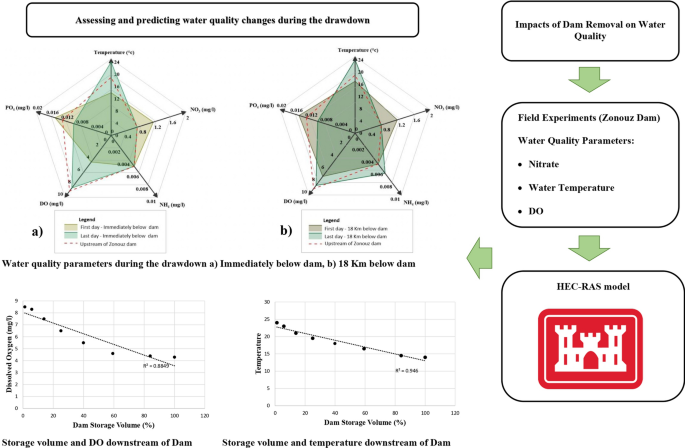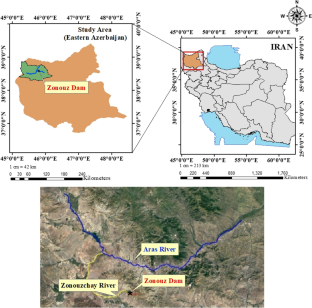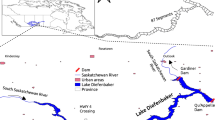Abstract
For decades, dams around the world have been removed due to safety concerns, losses in reservoir volume, river restoration, and other reasons. Water quality changes after years of dam operation due to the presence of different phenomena in dam reservoirs. So, it is essential to examine water quality downstream following dam removal. The present study analyzes and predicts the short-term effects of removing the dam on water quality, including temperature, dissolved oxygen, and nitrate. The Zonouz Dam in East Azerbaijan Province, Iran, is investigated as a case study. In this study, HEC-RAS is used to simulate water quality parameters downstream. The reservoir’s drawdown is assumed to be performed by releasing water from its bottom outlet for water quality simulations. Three different scenarios were used for the dam’s bottom outlet based on the ratio of openings (opening ratio = 0.5, 1, 1–0.5). Results show that in the first days of dam removal, the downstream river water temperature and dissolved oxygen concentration decreased by 3 °C and 3 mg/l, respectively. However, it increased in the next days, and finally, it reached 24 °C and 8.5 mg/l. There is also a decreasing trend in nitrate concentration over time. In the studied case, nitrate concentration showed a value of 1.13 mg/l, which fell to 0.7 mg/l on the last day of the reservoir’s drawdown. In addition, the data after dam removal revealed that the maximum amount of “qualitative parameters” was transferred to long distances from the dam with a very small change in concentration (in this study, these parameters were transported 18 km from the dam).
Graphical Abstract










Similar content being viewed by others
Abbreviations
- \(A_{T}\) :
-
Cross-sectional area
- Q :
-
Flow discharge
- x :
-
Distant along the channel
- \(q_{{\text{l}}}\) :
-
The lateral inflow
- v :
-
Velocity
- g :
-
Acceleration of gravity
- \({{\partial Z} \mathord{\left/ {\vphantom {{\partial Z} {\partial x}}} \right. \kern-0pt} {\partial x}}{ }\) :
-
The water surface slope
- \(S_{{\text{f}}}\) :
-
Friction slope
- V :
-
Volume of water quality cell
- \(\varphi\) :
-
Concentration of water quality parameter
- \(\Gamma\) :
-
Dispersion coefficient
- S :
-
Sources or sinks
- I i :
-
Sub-index for ith water quality parameter
- W i :
-
Weight associated with ith water quality parameter
- n :
-
Number of water quality parameters
- Osat :
-
Dissolved oxygen concentration at saturation
- \(\beta_{2}^{*}\) :
-
Rate constant: NO2 → NO3
- KNR:
-
Nitrification inhibition coefficient
- F 1 :
-
\(F_{1} = \frac{{P_{{\text{N}}} {\text{NH}}_{4} }}{{P_{{\text{N}}} {\text{NH}}_{4} + \left( {1 - P_{{\text{N}}} } \right){\text{NO}}_{3} }}\)
- α 1 :
-
Fraction algal biomass that is nitrogen
- μ :
-
Local growth rate for algae
- α 3 :
-
O2 production per unit algal growth
- α 4 :
-
O2 uptake per unit algal growth
- ρ :
-
Algal local respiration rate
- \(K_{4}^{*}\) :
-
Sediment oxygen demand rate
- d :
-
Average channel depth
- α 5 :
-
O2 uptake per unit NH4 oxidized
- β 1 :
-
Rate constant: NH4 → NO2
- \(K_{1}^{*}\) :
-
O2 uptake per unit NO2 oxidized
- \(K_{2}^{*}\) :
-
Deoxygenation rate
- P N :
-
Preference factor for ammonia
References
Abbott KM, Zaidel PA, Roy AH, Houle KM, Nislow KH (2022) Investigating impacts of small dams and dam removal on dissolved oxygen in streams. PLoS ONE 17(11):1–23. https://doi.org/10.1371/journal.pone.0277647
Al-Murib MD, Wells SA (2019) Hydrodynamic and total dissolved solids model of the Tigris river using CE-QUAL-W2. Environ Process 6:619–641. https://doi.org/10.1007/s40710-019-00381-y
American Rivers (2005) The ecology of dam removal. Washington, DC
Artioli Y, Bendoricchio G, Palmeri L (2005) Defining and modelling the coastal zone affected by the Po River (Italy). J Ecol Model 184(1):55–68
Barillier A, Garnier J, Coste M (1993) Experimental reservoir water release: Impact on the water quality on a river 60 km downstream (upper Seine River, France). Water Res 27(4):635–643
Bednarek AT (2001) Undamming rivers: a review of the ecological impacts of dam removal. Environ Manag 27(6):803–814
Bellmore JR, Pess GR, Duda JJ, Connor JE, East AE, Foley MM, Wilcox AC, Major JJ, Shafroth PB, Morley SA, Magirl CS, Anderson CW, Evans JE, Torgersen CE, Craig LS (2019) Conceptualizing ecological responses to dam removal: If you remove it, what’s to come? Bioscience 69(1):26–39
Benaman J (1996) Modeling of dissolved oxygen in the huston ship channel using WASP5 and geographical information systems. University of Texas, Austin
Bottino F, Ferraz IC, Mendiondo EM, do Carmo Calijuri M (2011) Calibration of QUAL2K model in Brazilian micro watershed: effects of the land use on water quality. Acta Limnol Bras 22(4):474–485
Bushaw-Newton KL, Hart DD, Pizzuto JE, Thomson JR, Egan J, Ashley JT et al (2002) An integrative approach towards understanding ecological responses to dam removal: the Manatawny Creek study. J Am Water Resour Assoc 38:1581–1599
Chapra SC, Pelletier GJ (2003) QUAL2K: a modeling frame work for simulating river and stream water quality: documentation and user’s manual, civil and environmental department. Tufts University, Medford
Chung SW, Ko IH, Kim YK (2008) Effect of reservoir flushing on downstream river water quality. J Environ Manag 86(1):139–147
Cortes RMV, Peredo A, Terêncio DPS, Sanches Fernandes LF, Moura JP, Jesus JJB, Magalhães MPM, Ferreira PJS, Pacheco FAL (2019) Undamming the Douro river catchment: a stepwise approach for prioritizing dam removal. Water 11:693. https://doi.org/10.3390/w11040693
Cox BA (2003) A review of currently available in-stream water quality models and their applicability for simulating dissolved oxygen in lowland rivers. Sci Total Environ 314:335–377
Crisp DT (1977) Some physical and chemical effects of the Cow Green (Upper Teasdale) impoundment. Freshw Biol 7:109–120
Duda JJ, Bellmore JR (2022) Dam removal and river restoration. In: Mehner T, Tockner K (eds) Encyclopedia of inland waters, 2nd edn. Elsevier, Amsterdam, pp 576–585. https://doi.org/10.1016/B978-0-12-819166-800101-8
Guetz K, Joyal T, Dickson B, Perry D (2022) Prioritizing dams for removal to advance restoration and conservation efforts in the western United States. Restor Ecol 30(5):2022. https://doi.org/10.1111/rec.13583
Hamilton SK, Murphy CA, Johnson SL, Pollock A (2022) Water quality ramifications of temporary drawdown of Oregon reservoirs to facilitate juvenile Chinook salmon passage. Lake Reserv Manag 38(2):165–179
HEC-RAS 5.0 Reference manual
John Heinz III Center for Science and the Environment EH (2002) Dam Removal. Science and Decision Making. H. John Heinz III Center for Science, Economics and the Environment
Kannel PR, Lee S, Lee YS, Kanel SR, Pelletier GJ (2007) Application of automated QUAL2Kw for water quality modeling and management in the Bagmati river, Nepal. Ecol Model 202:503–517
Kim J, Jonoski A, Solomatine DP, Goethals PLM (2023) Water quality modelling for nitrate nitrogen control using HEC-RAS: case study of Nakdong River in South Korea. Water 15:247. https://doi.org/10.3390/w15020247
Lei Y, Dong F, Liu X, Ma B, Huang W (2022) Short-term variations and correlations in water quality after dam removal in the Chishui river basin. J Environ Manag 327:1–10. https://doi.org/10.1016/j.jenvman.2022.116917
Lindenschmidt KE, Carr MK, Sadeghian A, Morales-Marin I (2019) CE-QUAL-W2 model of dam outflow elevation impact on temperature, dissolved oxygen and nutrients in a reservoir. Sci Data 6:312. https://doi.org/10.1038/s41597-019-0316-y
Michie LE, Hitchcock JN, Thiem JD, Boys CA, Mitrovic SM (2020) The effect of varied dam release mechanisms and storage volume on downstream river thermal regimes. Limnologica 81:125760
Naselli-Flores L, Barone R (2005) Water-level fluctuations in Mediterranean reservoirs: setting a dewatering threshold as a management tool to improve water quality. Hydrobiologia 548:85–99
Nechvatal MD (2004) Effects of dam removal on water quality variables. M.Sc. thesis, Master of Science in Civil Engineering, The Ohio state university, Ohio
Palmieri V, de Carvalho RJ (2006) Qual2e model for the Corumbatai River. Ecol Model 198:269–275
Park SS, Lee YS (2002) Water quality modeling study of the Nakdong river, Korea. Ecol Model 152:66–75
Pelletier GJ, Chapra SC, Tao H (2006) QUAL2Kw-a framework for modeling water quality in stream and rivers using a genetic algorithm for calibration. Environ Model Softw 21:419–425
Riggsbee JA (2006) Short-term nutrient and sediment fluxes following dam removal. PhD. thesis, Doctor of Philosophy in Environmental Engineering, the University of North Carolina, Chapel Hill, US
Schenk LN, Bragg HM (2014) Assessment of suspended-sediment transport, bedload, and dissolved oxygen during a short-term drawdown of Fall Creek Lake, Oregon, winter. U.S. Geological Survey Open-File Report
Wall D (2013) Nitrogen in waters: forms and concerns. Minnesota Pollution Control Agency
Xu H, Pittock J (2021) Policy changes in dam construction and biodiversity conservation in the Yangtze River Basin, China. Mar Freshw Res 72:228–243
Zakaullah, Ejaz N, Zafar A (2022) An integrated approach for water quality modelling of Soan river using HEC-RAS. J Appl Eng Sci 12(1):121–128. https://doi.org/10.2478/jaes-2022-0017
Zhang Y (2012) Predicting river aquatic productivity and dissolved oxygen before and after dam removal in Central Ohio, USA. M.Sc. Thesis, Master of Science in Environmental Science, The Ohio State University, Ohio, US
Acknowledgements
This research did not receive any specific grant from funding agencies in the public, commercial, or not-for-profit sectors.
Author information
Authors and Affiliations
Corresponding author
Ethics declarations
Conflict of interest
The authors declare that they have no known competing financial interests or personal relationships that could have appeared to influence the work reported in this paper.
Rights and permissions
Springer Nature or its licensor (e.g. a society or other partner) holds exclusive rights to this article under a publishing agreement with the author(s) or other rightsholder(s); author self-archiving of the accepted manuscript version of this article is solely governed by the terms of such publishing agreement and applicable law.
About this article
Cite this article
Pourabedini, P., Banihashemi, S.M.A. & Akbari, Z. Impacts of Dam Removal on Water Quality: Case Study of Zonouz Dam. Iran J Sci Technol Trans Civ Eng (2024). https://doi.org/10.1007/s40996-024-01358-0
Received:
Accepted:
Published:
DOI: https://doi.org/10.1007/s40996-024-01358-0




